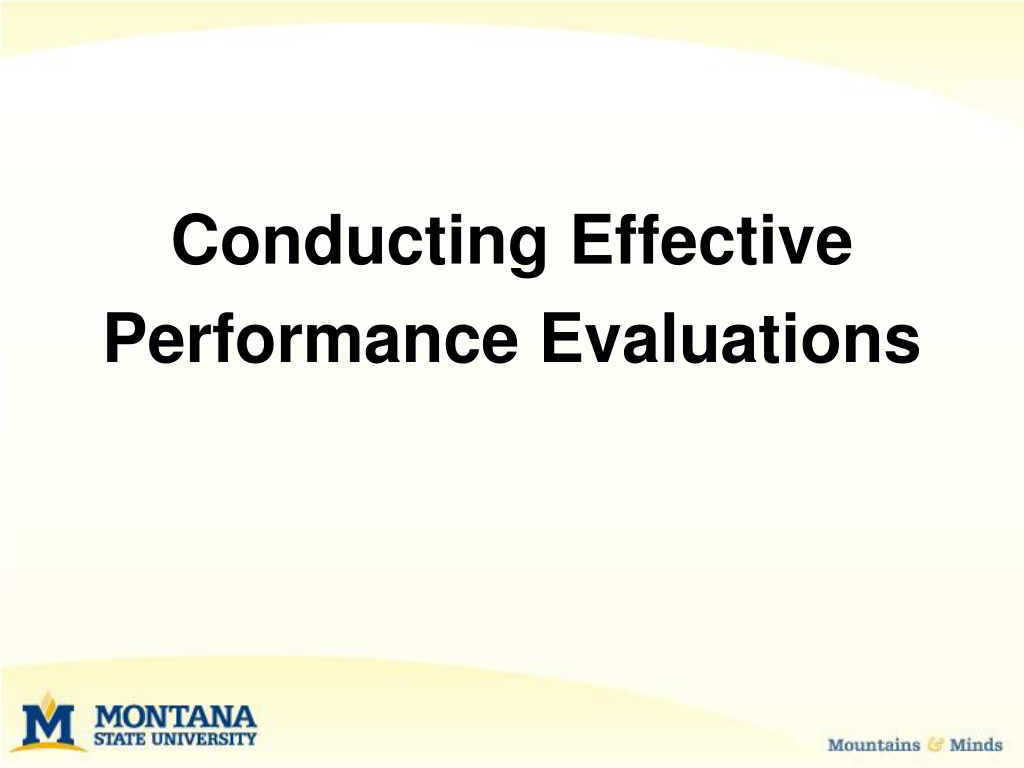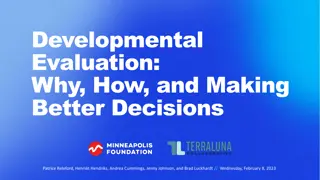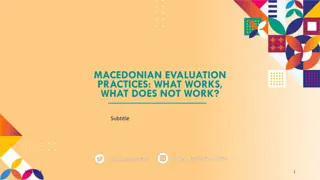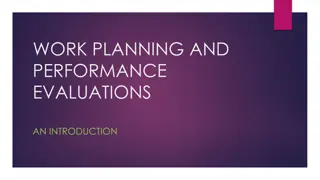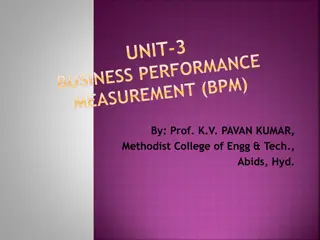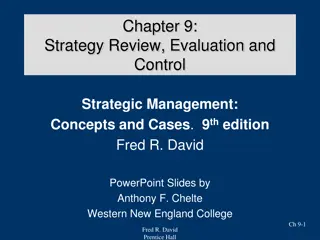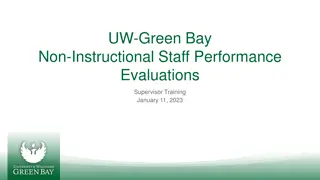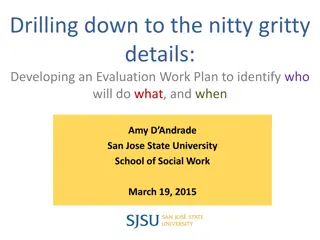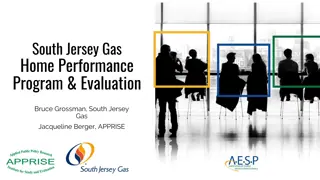Effective Performance Evaluation Strategies for Success
Discover best practices for conducting effective performance evaluations, including hiring the best people, providing clear expectations, communication strategies, and the importance of training. Learn how to utilize foundational tools like job descriptions and mission statements, set clear expectations, offer training opportunities, and provide performance feedback. Understand the differences between performance management and performance evaluation to ensure a comprehensive approach to achieving organizational goals and supporting employee growth.
Download Presentation

Please find below an Image/Link to download the presentation.
The content on the website is provided AS IS for your information and personal use only. It may not be sold, licensed, or shared on other websites without obtaining consent from the author.If you encounter any issues during the download, it is possible that the publisher has removed the file from their server.
You are allowed to download the files provided on this website for personal or commercial use, subject to the condition that they are used lawfully. All files are the property of their respective owners.
The content on the website is provided AS IS for your information and personal use only. It may not be sold, licensed, or shared on other websites without obtaining consent from the author.
E N D
Presentation Transcript
Conducting Effective Performance Evaluations
Best Practices Hire the Best People Train them Well Establish Clear Expectations Communicate Manage Performance
How? Foundational Tools Job Description/Vacancy Announcement Hire based on the advertised criteria Duties and Responsibilities Mission Statement Core Values MSU Service Excellence Safety Courtesy Reliability Competence Strategic Plan Departmental expectations
Training Identify opportunities for growth and skill development On-the-Job Across campus through HR PD&T Off-campus outside resources
Clear Expectations Job Description Clarifies job responsibilities and expectations Provides a framework for focused conversations about expectations Provides the ability to be straight forward, respectful, polite factual May be used in legal situations
Communicate Individually and in staff meetings Engage staff in problem-solving when appropriate Keep employees apprised of work conditions
Performance Feedback Feedback is the most effective way to support and encourage employees. Use this tool to communicate expectations, reinforce/increase desired performance or to help address poor performance. To be effective, it must be: Immediate Objective Specific
Performance Management vs. Performance Evaluation Performance Management is: Process in which managers, supervisors, and employees work together to accomplish the mission, goals and objectives of the organization Ongoing Prospective- looking forward
Performance Evaluation - Intent Two-way communication between employee and supervisor Facilitate development and growth Retrospective - documenting prior year s work
Things to Keep in Mind Important to set a proper example role model desired behaviors Set the course Few jobs remain constant- early, initial feedback is vital Expectations must be clear Silence = condoning; approval of behaviors
Performance Evaluation Annual event Based on the job duties as outlined in the job description Focused on: performance of duties work expectations
Performance Management: Performance Evaluation Annual performance evaluation is required for classified and contract professional employees (0.5 FTE or greater) Classified probationary employees conduct the evaluation upon conclusion of the probationary period Policy:https://www.montana.edu/policy/hr_policies/perfo rmance_evaluation.html Forms: https://www.montana.edu/hr/employee-labor- relations/EmployeeRelations.html (Any alternate forms must be approved by Employee and Labor Relations in advance.)
Preparing for the Evaluation Plan ahead Determine the standards to be used Departmental/work unit standards Service Excellence standards Recognize areas of strength and good performance Identify areas of weakness and patterns of poor or unacceptable performance Develop a plan to improve performance with deadlines and milestones Prepare a draft Set aside sufficient time Give the employee opportunity to self-evaluate prior to the review
Conducting the Evaluation Provide the evaluation in writing in advance Meet face-to face Help the employee feel comfortable Be discreet and maintain confidentiality Keep the discussion professional Maintain objectivity Provide the employee with an opportunity to comment and ask questions actively listen
Conducting the Evaluation Focus on job performance skills, activities, outcomes behavior, conduct Be accurate, specific, give examples Be consistent in measuring and communicating the extent to which those expectations are being met Reasonable indicators of successful performance are expressed in terms of quality, quantity, timeliness, cost
Rating Scale Exemplary Unequivocally superior performance (No one could possibly do this job better). Strong Performance is strong and contributes significantly to achieving the department s mission (You would really hate it if this person left MSU). Acceptable Performance meets all expectations of the role and is a valued contributor to the success of the department s mission (Baseline expectations are consistently met; solid performance).
Rating Scale (continued) Consult with your HRBP before rating an employee as below: Below Expectations Certain aspects of the performance do not meet expectations and could be improved. (Talk to your HR Business Partner.) Unacceptable Performance does not meet expectations and must be improved. (Talk to your HR Business Partner.)
Common Rating Errors Halo/Horn opinion of one quality influences the opinion of other qualities. All the same rating. Central Tendency everyone in the middle, lack of rating between employees. Leniency avoids honest ratings to avoid conflict everyone near the top. Recency greater weight to recent occurrences or events Similarity/Like me favorable rating to employees who have similar values or interests to the rater
Do Not - Surprise the employee. Nothing contained within the evaluation should be the first time the employee is hearing about it. - Take an informal approach. This is a formal official document and process -Don t discriminate See Policies on Non-Discrimination at https://www.montana.edu/policy/discrimination/index.html - Focus on personality or generalities - Apologize for a poor rating
Do Not - Generalize individual problems to the group- these should be directly addressed - Compare to or discuss other employees - Move directly to punishment (talk to your HRBP) - Ignore patterns of poor job performance - Become involved in personal problems
Personal Problems & Substance Abuse Issues in the Workplace Get help ask your HRBP Don t diagnose you are not a doctor Don t run afoul of ADA or FMLA
Disagreements Rebuttal process; No grievance process An employee who disagrees with the evaluation of his or her supervisor may submit a written request for review by the supervisor s supervisor. The written request must outline the specific areas of disagreement and the reasons the employee disagrees with the supervisor s evaluation. The decision of the supervisor s supervisor will be the final decision on the evaluation. The employee s written disagreement will be included as part of the final performance evaluation.
Details Employee & Supervisor must sign the evaluation The employee s signature on the form indicates the meeting took place and not agreement of the contents. Please route for signatures through DocuSign, with perfomanceevaluations@montana.edu receiving a copy. Please include the Cover sheet with the following: Legal Name GID last 4 digits Position Number Employee Position Number Supervisor
Questions? Reach out to your Human Resources Business Partner
